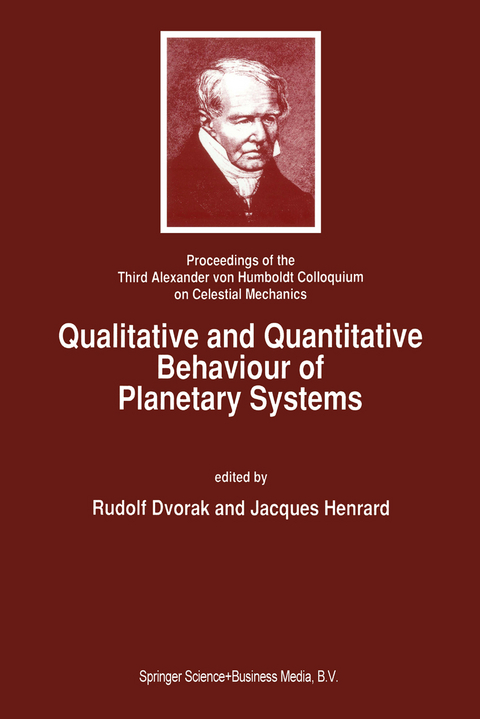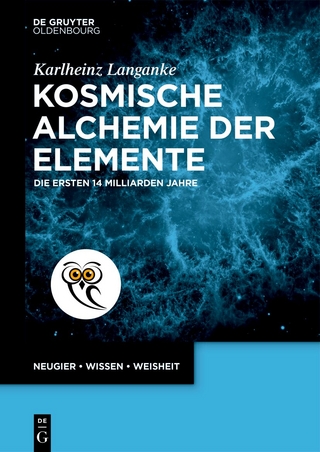
Qualitative and Quantitative Behaviour of Planetary Systems
Springer (Verlag)
978-94-010-4898-9 (ISBN)
The success of the two first Alexander von Humboldt Colloquia on Celestial Mechanics (March 1984 and March 1988) encouraged us to meet again this year from March 29 to April 4, 1992 in the " Alpengasthof Peter Rosegger" in the Styrian Alps (Ramsau, Austria). This time the colloquium was devoted to the "Qualitative and Quantitative behaviour of Planetary Systems". The papers covered a large range of questions of current interest from the behaviour of dust particles to the stability of the Solar System as a whole, without forgetting the motion of Asteroids and their classification into families. KAM theory, chaotic motions, resonances, Lyapunov characteristic exponents, perturbation theory, numerical integration were - of course - on the menu every day, served with sauces and accents from various part of the world: from China, from Brazil, from the United States and from all over Europe. To be able to organize this - now well established - meeting , we have to thank primarily the munificence of the Austrian Ministry of Science, furthermore the Steiermarkischen Wissenschafts- und Landesfonds and the Osterreichische Nationalbank for financial support.
Also, the Osterreichische Forschungsgemein- schaft and the University of Vienna made it possible to invite participants to this meeting from abroad. Support in form of "Tagungsunterlagen" was given by the Creditanstalt-Bankverein in Vienna and coffee during the whole meeting time was donated by Homig-Kaffee Graz.
Session on Planetary Theories.- Review of Planetary and Satellite Theories.- The Mystery of Pluto’s Mass — The Ring Hypothesis.- Recent progress in the theory and application of symplectic Integrators.- Stable Planetary Orbits Around One Component in Nearby Binary Stars.- Stability of Outer Planetary Orbits Around Binary Stars: a Comparison of Hill’s and Laplace Stability Criteria.- An Excess Motion of the Ascending Node of Mercury in the Observations Used by Le Verner.- Session on the Sitnikov Problem.- Numerical Results to the Sitnikov-Problem.- A Computer Aided Analysis of the Sitnikov Problem.- The Original Sitnikov Article — New Insights.- Session on Asteroids.- Proper Elements: What are They?.- The High Eccentricity Libration of the Hildas II: Synthetic-Theory Approach.- A Stability Study of Asteroid Families Near the 3:1 and 5:2 Resonance with Jupiter.- Chaotic Behaviour of Trajectories for the Asteroidal Resonances.- Low-Eccentricity Motion of Asteroids Near the 2/1 Jovian Resonance.- Numerical Experiments in the 3/1 and v6 Overlapping Resonance Region.- Session on Resonance Problems.- An Introduction to Hamiltonian Dynamical Systems and Practical Perturbation Methods: New Insight by Successive Elimination of Perturbation Harmonics.- Frequency Analysis of a Dynamical System.- An Application of KAM Theory to the Planetary Three Body Problem.- Resonant Motion in the Restricted Three Body Problem.- A Fourth-Order Solution of the Ideal Resonance Problem.- Session on General Dynamical Systems.- Wavelet Analysis and Applications to Some Dynamical Systems.- Wavelet Analysis of the Standard Map: Structure and Scaling.- Asteroids: 2/1 Resonance and High Eccentricity.- On the Second Order Long-Period Motion of Hyperion.- The Problem of Critical InclinationCombined with a Resonance in Mean Motion in Artificial Satellite Theory.- Session on Chaos and Stability.- Meteorites from the Asteroid 6 Hebe.- Generalized Lyapunov-Characteristic Indicators and Corresponding Kolmogorov like Entropy of the Standard Mapping.- Generalized Lyapunov Exponents Indicators in Hamiltonian Dynamics: An Application to a Double Star System.- Asteroid 522 Helga is Chaotic and Stable.- Session on Miscellaneous Problems.- Classical Periodic Orbits and Quantum Mechanical Eigenvalues and Eigenfunctions.- Generalized Least-Squares Adjustments: A Timely but Much Ignored Tool.- Least Squares Parameter Estimation in Chaotic Differential Equations.- The arrangement in Mean Elements Space of the Periodic Orbits Close to that of the Moon.- Resonance Trapping of Circumstellar Dust Particles by an Alleged Planet.- Orbital Resonances and Poynting-Robertson Drag Confining Dust Particles in ?-Pic Disk.
| Zusatzinfo | IX, 396 p. |
|---|---|
| Verlagsort | Dordrecht |
| Sprache | englisch |
| Maße | 160 x 240 mm |
| Themenwelt | Naturwissenschaften ► Physik / Astronomie ► Astronomie / Astrophysik |
| ISBN-10 | 94-010-4898-3 / 9401048983 |
| ISBN-13 | 978-94-010-4898-9 / 9789401048989 |
| Zustand | Neuware |
| Informationen gemäß Produktsicherheitsverordnung (GPSR) | |
| Haben Sie eine Frage zum Produkt? |
aus dem Bereich


